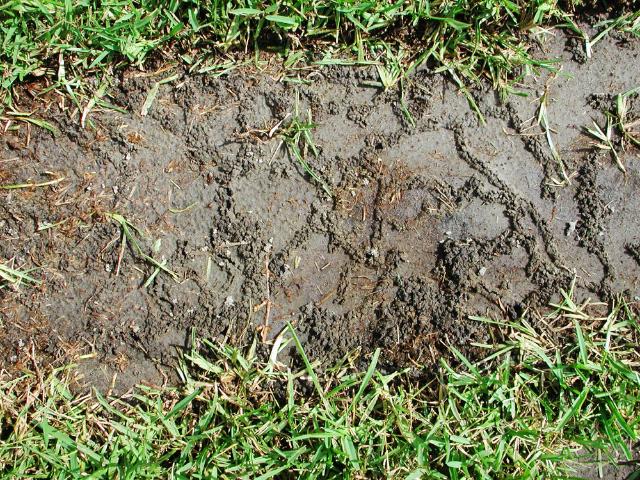
by Larry Williams | Apr 20, 2015
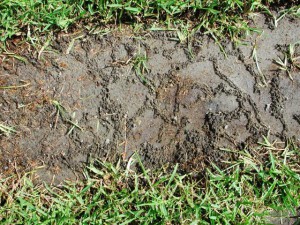
Mole cricket tunnels. Credit: N. Leppla, UF/IFAS
Many people treat their lawn with an insecticide when they see mole crickets in the spring or at the first sign of a brown area in their lawn. What they don’t understand is the biology of this pest.
Mole crickets spend the winter as adults in the soil. As temperatures warm in late February and March, adult mole crickets emerge and begin to mate. Male mole crickets construct a chamber in the soil and chirp to attract female crickets. Attracted females fly to the males. After mating, males die and females fly to a suitable area for egg laying. Mated females begin tunneling and laying eggs in the tunnels. They lay about four clutches of eggs in different areas, averaging 35 eggs per clutch. Female crickets die shortly after laying their eggs.
Use of insecticides during early spring is not recommended because:
- adult mole crickets are not easily killed
- they cause minimal lawn damage during the mating and egg laying process, and,
- reinfestation from subsequent flights is likely.
The best time to treat for mole crickets is during mid-June through July. This will be when eggs have hatched but before the nymphs (immature mole crickets) are large enough to do much damage. Proper timing of the insecticide application is very important to achieve control.
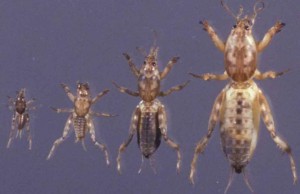
Mole cricket nymphs. Credit: J. Castner, UF/IFAS
If you are not sure if mole crickets are present, you can find out with a soap solution. Mix 1½ fluid ounces of a lemon scented liquid dishwashing soap in two gallons of water in a sprinkling can or bucket. Pour the soapy water over an area approximately four square feet and count the number of mole crickets that emerge. If they are present, it only takes several minutes for mole crickets to crawl to the surface after the soap treatment. Repeat the process around the yard where you suspect mole cricket problems. If you flush an average of two to four crickets per site, treat the lawn with an insecticide. Follow up with spot treatments if any crickets escape the first insecticide treatment. But don’t treat at all if there is no evidence of mole cricket activity.
There are a number of products for mole cricket control in home lawns. Look for insecticides that contain the following active ingredients: bifenthrin, carbaryl, cyfluthrin, deltamethrin, imidacloprid , lambda-cyhalothrin or permethrin.
Before using any product for mole cricket control first identify the problem as mole cricket damage by using the soap flush technique. Then choose an insecticide that lists mole crickets on its label. And finally, read the container carefully for use directions, application techniques, irrigation requirements and precautions.
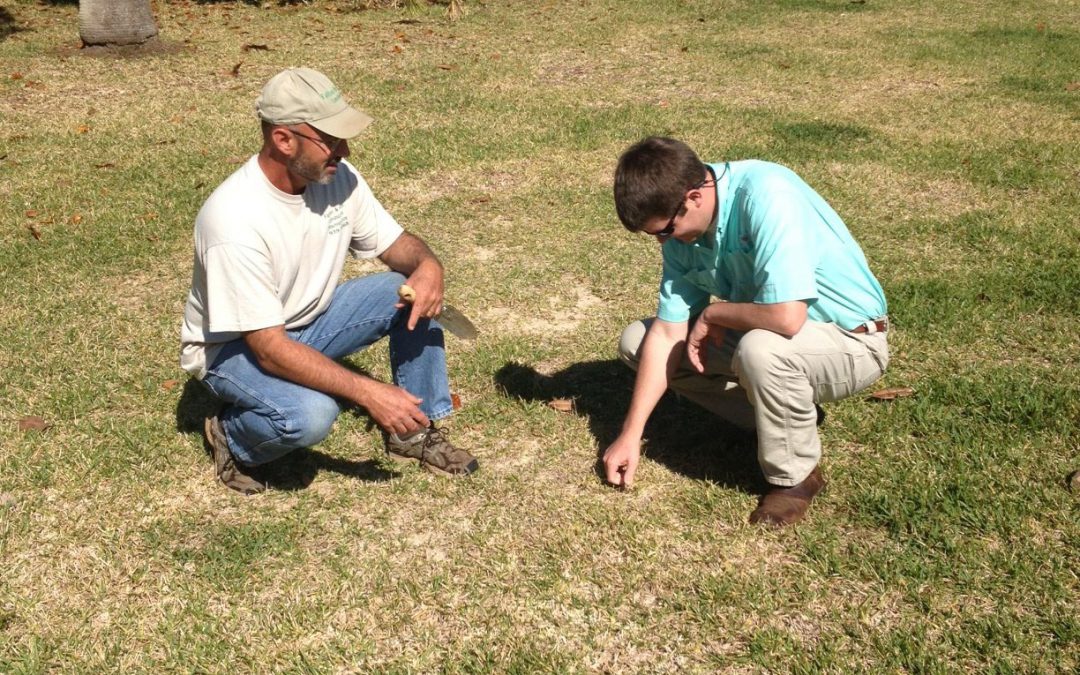
by Blake Thaxton | Mar 24, 2015
Some times the lawn just gets away from us. It can be completely invaded by weeds or have a devastating disease or insect pest cause total destruction. If your lawn is problem prone there are many cultural practices that can be modified to ensure a successful lawn, but sometimes the lawn is in need of a fresh start and needs to be completely reestablished. If over 50% of the lawn is undesirable than it is time to take action to develop better lawn.
What are the factors that may have caused your lawn to decline so badly? Well here are some common problems that may need to be overcome as you move your lawn into its new era:
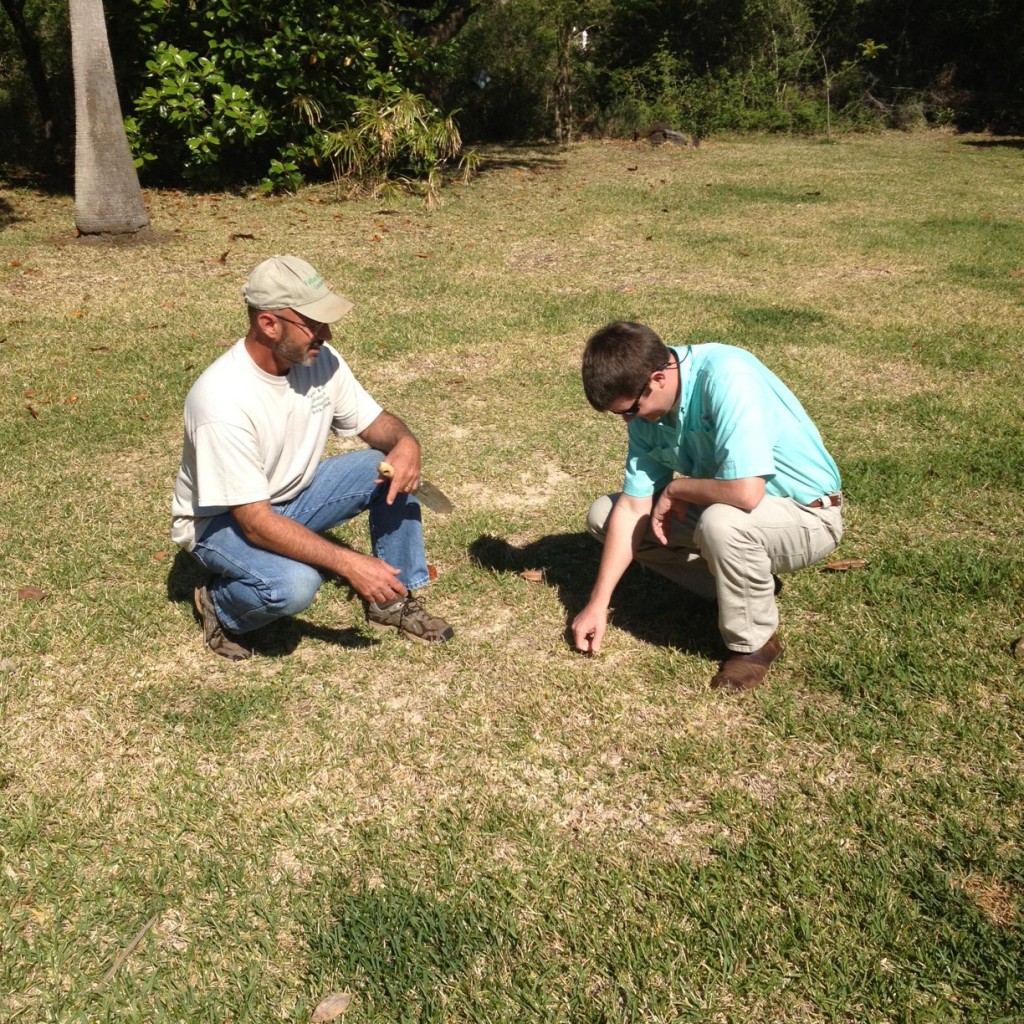
Contact your local UF/IFAS Extension Agent for lawn recommendations, Photo Credit: Blake Thaxton
As a new lawn is established, correcting these problems will help to ensure the investment will be better taken care of in the future.
Which turf should I choose for my next lawn? Try to answer these questions before you decide:
- How much maintenance can I provide?
- What do I expect aesthetically?
- Are there any site limitations ?
Here is a publication from Alabama Cooperative Extension to help you choose the correct turfgrass for your next lawn: Selecting Turfgrasses for Home Lawns (while looking at the tables use the South adaptation for the Florida panhandle)
Once the turfgrass type has been chosen, a variety must be chosen. Here are some recommendations:
- Centipede – ‘Common’
- Zoysia – ‘Empire’, ‘UltimateFlora’, ‘El Toro’
- St. Augustine – ‘Palmetto’, ‘Classic’
Get more information on Lawn Management in the Florida Lawn Handbook
by Mary Salinas | Feb 2, 2015
So often, homeowners wait until weeds have overtaken their lawns in mid-summer before looking for a course of action to control them. Unfortunately, when weeds get to maturity and start producing flowers and going to seed, they are usually quite difficult to control.
[important]The best strategy is to prevent the weeds from getting established in the first place![/important]
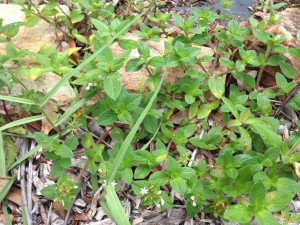
Florida pusley, an annual weed that can be controlled with preemergence herbicides. Photo credit: Mary Derrick UF/IFAS Extension.
When properly applied, a preemergence herbicide forms a chemical barrier on the surface of the soil that kills newly germinated seeds when they grow and contact that barrier. Be sure to follow label directions carefully as it is crucial to apply the correct amount and water it in correctly. The soil surface should not be disturbed after application to ensure that the chemical barrier remains intact.
Keep in mind that preemergence herbicides only prevent annual weeds! They do not control weeds that have already emerged.
In North Florida, the time to apply a preemergence herbicide to your turfgrass is coming soon. As a general rule, March 1 is an ideal time. Another indicator that the time is right is when the daytime temperatures reach 65°F-70°F for 4 to 5 consecutive days as that sustained warmth will prompt weed seeds to germinate. Oftentimes, this is also when azaleas or dogwoods start blooming and that can clue you into when to apply the herbicide. For best results, follow up with a second application in 6 to 9 weeks to control those seeds germinating later in the season.
Always follow the label instructions precisely when applying any herbicide! Ensure that you apply the product at the correct rate, that it is suitable for your specific turfgrass and situation, and that it is watered in correctly. For any pesticide, the label is the law!
If your lawn has problems with winter weeds, make a note on your calendar to apply a preemergence herbicide about October 1 in North Florida or when nighttime temperatures drop to 55°F-60°F for several consecutive days.
For more information on weed control in lawns:
Weed Management Guide for Florida Lawns
For general information on lawn care in Florida:
UF/IFAS Gardening Solutions: Lawns
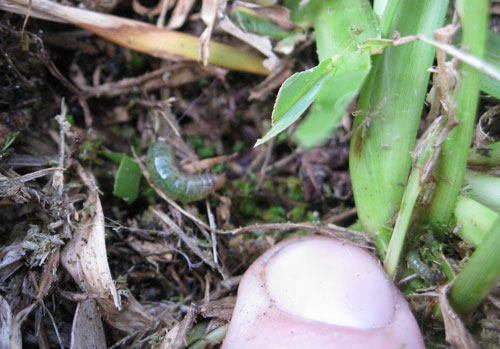
by Taylor Vandiver | Sep 9, 2014
What’s eating my lawn? Does your grass look ragged in areas, as if someone randomly used a weed-eater here and there? Are you noticing brown patches that have a closely clipped appearance compared to other areas of your lawn? Your turf may be playing host to Tropical Sod Webworm.
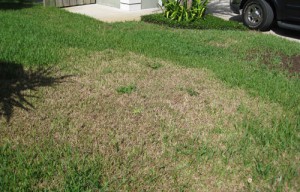
Sod webworm damage in a home lawn. Photo courtesy UF/IFAS.
Sod webworm damage is subtle at first. You have to look closely to notice larval feeding damage. However, an easy indication of their presence is the light tan/brown colored moths, which are the adult stage of the pest. You may see them fly up as you walk through your lawn or if you disturb a nearby bush. The moths do not cause any damage to the turf, but they are depositing eggs, which will result in their offspring, the caterpillars, who do all the chewing damage.
The larvae are gray-green and have spots on each segment. The mature larvae can be up to 1 inch in length. Larvae will curl up in the soil during the day and feed at night. So if you happen to notice caterpillars feeding during the day, it’s probably not sod webworm. You will notice chewed notches along the leaf blade, holes in the leaf and even leaf blade skeletonizing. The older the larvae are, the more they will eat. Damage may start out as a ragged appearance in your turf, which can be hard to diagnose. However, if left unchecked, sod webworm can cause considerable injury to your lawn.
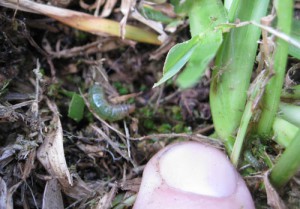
Sod webworm larvae. Photo courtesy UF/IFAS.
If you are uncertain of their presence you can always use a soap drench to flush out larvae. Mix 2 tablespoons of dish soap with 2 gallons of water and pour it over a damaged area (about 3 square ft.). The soap mixture will irritate the pest and bring them to the surface so you can easily identify them. If nothing appears in the area tested move to another damaged site and try again. Here is a link to a video that will give more information on identifying Tropical Sod Webworm.
Tropical Sod Webworm is considered a pest of all warm-season turfgrasses. However, St. Augustinegrass is most commonly affected. The best way to prevent a pest infestation is to use proper cultural maintenance practices for your lawn type. However, if the pest does appear, chemical control should be targeting the larvae stage of the pest. There are multiple products marketed to control lawn caterpillars. However, you may want to consider using B.t. (Bacillus thurengiensis), which is a bacterium that will only harm caterpillars and not bother beneficial insects that may be in your lawn. For more information you can contact your local extension office.
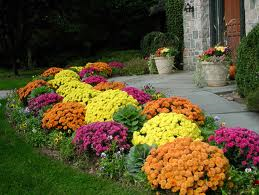
by Larry Williams | Sep 9, 2014
The Emerald Coast Home Show, Health Fair and Business Expo will include lawn and landscape seminars and an information booth hosted by the Okaloosa County Master Gardeners. This event will take place September 13 and 14 at the Emerald Coast Convention Center, 1250 Miracle Strip Parkway in Fort Walton Beach. The horticulture seminars will be provided by the UF/IFAS Extension Office in Okaloosa County.
 A feature of the Emerald Coast Home Show Health Fair and Business Expo will be an information booth hosted by the Okaloosa County Master Gardeners. Master Gardeners will be on hand to answer your gardening questions and to distribute information pertinent to gardening and lawn care on the Gulf Coast.
A feature of the Emerald Coast Home Show Health Fair and Business Expo will be an information booth hosted by the Okaloosa County Master Gardeners. Master Gardeners will be on hand to answer your gardening questions and to distribute information pertinent to gardening and lawn care on the Gulf Coast.
In addition to an information booth hosted by Master Gardeners, free educational seminars will be provided. On Sunday, September 14, I will provide a one hour seminar at 1p.m. entitled “Preparing Your Lawn for Fall and Winter.” This presentation will answer questions concerning preparing your lawn for the dormant period of winter. What’s the truth about” winterizer” fertilizers? Do you need to “winterize” your lawn? How should you water your lawn through the fall and winter? Should you overseed your lawn with annual ryegrass? What should you do about winter weeds in your lawn? What lawn pests are active during fall and winter? Learn the answers to these questions and the truth about winter lawn care for North Florida by attending the Preparing Your Lawn for Fall and Winter seminar.
The complete schedule of free seminars includes the following.
Saturday, September 13
11a.m. Margaret Stewart – Herbs, growing, using and preserving
1p.m. Scott Berry – Orchid basics
3 p.m. Karen Kirk-Williams – Great plants for fall and winter color
Sunday, September 14
1 p.m. Larry Williams – Preparing Your Lawn for Fall and Winter
2 p.m. Marie Harrison – Help! Pollinators in peril
The Emerald Coast Home Show, Health Fair and Business Expo will be open September 13 from 10 a.m. to 6 p.m. and September 14 from 11 a.m. to 4 p.m. and offers free admission, door prizes and giveaway items along with 100 vendors and free health care evaluations.
Visit www.emeraldcoasthomeshow.com for more information.










